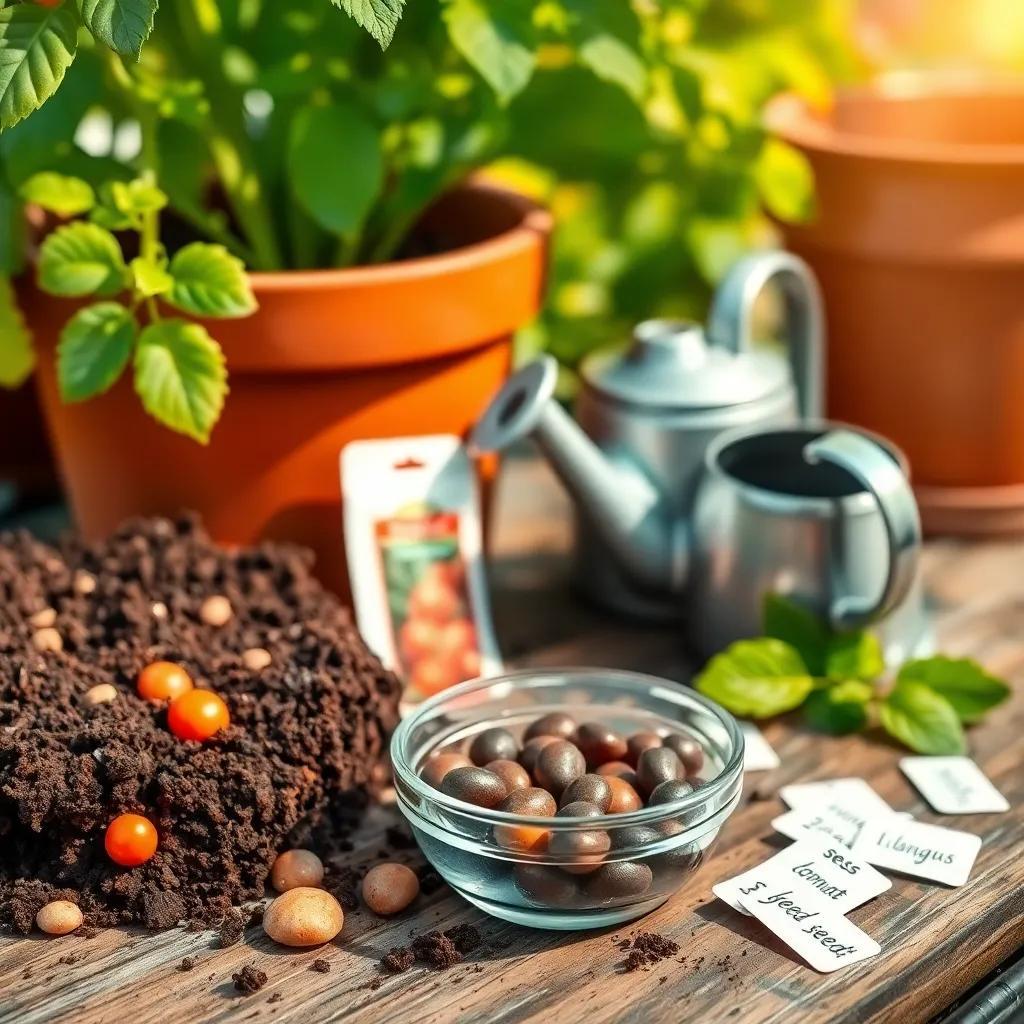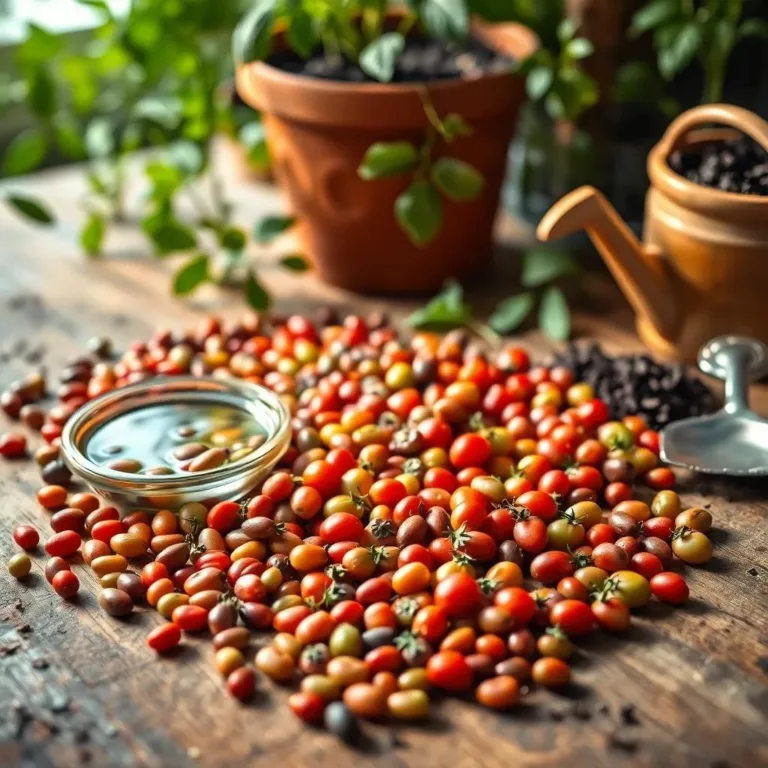Are you ready to grow your own juicy tomatoes? It’s easier than you might think! In this guide, I’ll walk you through the exciting journey of tomato germination, from selecting the best seeds to troubleshooting common hiccups. Let’s dig into the world of tomatoes and get those seeds sprouting!
Factors Influencing Tomato Seed Germination
When it comes to germinating tomato seeds, several factors can make a big difference! Understanding these can help us grow the healthiest plants possible. Let’s explore some of the key players in the germination game.
- Temperature: Most tomato seeds love warmth! Ideally, they prefer temperatures between 70°F to 85°F (21°C to 29°C). Too cool, and they might just sit there, sulking. Too hot, and they could fry! So, find that sweet spot for the best results.
- Moisture: Think of moisture as the magical potion that gets those seeds sprouting. Seeds need to be consistently moist, but not waterlogged. It’s like giving them a refreshing drink, but not drowning them! Using a spray bottle to mist the soil can keep it just right.
- Soil Quality: The soil you use is crucial! A well-draining seed-starting mix is your best friend here. It should be light and fluffy, allowing roots to reach down without feeling suffocated. Avoid heavy, compacted soil like the plague!
- Seed Quality: Have you ever heard the saying, “You get what you pay for”? This definitely applies to seeds! Always choose high-quality seeds from reputable suppliers. Fresh seeds with a good germination rate are more likely to sprout and grow into vibrant plants.
- Seed Depth and Spacing: When planting, remember to space your seeds properly! Typically, plant seeds about 1/4 to 1/2 inch deep in the soil. This keeps them cozy underground while giving them room to grow!
By monitoring these factors and giving your seeds a little TLC, you can increase your chances of healthy germination! Now that we’re warmed up, let’s move on to the next exciting part: the step-by-step germination process!
Step-by-Step Germination Process for Tomatoes
Now that we know what affects tomato seed germination, it’s time to roll up our sleeves and get to the fun part – the germination process itself! Here’s a simple guide to help you along the way.
- Seed Preparation: Before you even think about planting, give your seeds a little spa treatment! Soaking them in water for about 8-12 hours can help soften their outer coats. This little trick can lead to quicker germination!
- Sowing: Grab your seed-starting mix and fill your containers! Make small holes about 1/4 to 1/2 inch deep. Now, gently drop your seeds in and cover them up with a thin layer of soil. Give them a light pat – this is like tucking them into bed!
- Germination Phase: After planting, it’s time for the magic to happen! Seeds absorb moisture from the soil, causing their coats to break open. You’ll see a little root pushing down and a shoot reaching for the light. How cool is that?
- Root Development: As the root grows, it anchors into the soil. This is super important because it will help support the plant later! Roots are like the legs of the plant; they need to be strong!
- Shoot Emergence: Once the root is cozy, the shoot, which is the stem, will start to push its way out of the soil. This is where things get exciting! Before you know it, you’ll see those tiny leaves beginning to unfold.
- Seedling Growth: As your seedling grows, it will develop more leaves, making it look like a mini tomato plant! Just keep checking your moisture levels and provide plenty of warmth.
Following this step-by-step process will set you up for success! Watching those seeds sprout is a thrill like no other. You’re on your way to growing delicious tomatoes, so let’s keep the momentum going!

Germination Times for Various Tomato Varieties
One of the exciting aspects of growing tomatoes is the variety of types available! Each variety has its own personality, and that includes how quickly they sprout. Knowing the typical germination times for different tomato varieties can help you plan your garden better. Let’s break it down!
- Early-Maturing Varieties: These little gems, like ‘Early Girl’ and ‘Celebrity,’ usually sprout within 5-7 days. They’re perfect for those of us who can’t wait to see those first green shoots! If you’re in a hurry for fresh tomatoes, these are the ones to choose!
- Mid-Season Varieties: Mid-season tomatoes, such as ‘Better Boy’ and ‘Roma,’ typically take a bit longer, germinating in about 7-10 days. They offer a great balance between getting a jump start and allowing you some extra time to plan your planting schedule.
- Late-Maturing Varieties: If you’re feeling patient, then late-maturing varieties like ‘Brandywine’ and ‘Beefsteak’ are for you! These seeds might take 10-14 days to germinate. But let me tell you, the flavor of these tomatoes is worth the wait!
- Heirloom Varieties: These tomatoes come in many shapes and sizes, with germination times that can be all over the map. Some might sprout quickly, while others can take their sweet time.
Remember, these times can change based on temperature, moisture, and the quality of your seeds. So, keep an eye on those little guys and be patient—great things are coming!
Tips for Achieving Successful Tomato Germination
Now that we’ve got the germination times down, let’s talk about how to make the germination process smooth sailing! I’ve got some simple tips to help you achieve great results.
- Select Quality Seeds: Don’t skimp on seeds! Start with the best quality you can find. Fresh, viable seeds make all the difference in your germination success.
- Pre-Soak Your Seeds: Remember that spa treatment we talked about? Pre-soaking seeds overnight can speed up germination. It softens the hard seed coat and prepares them for sprouting. Just don’t forget to drain them before planting!
- Use the Right Soil: A well-draining seed-starting mix is key. It keeps your seeds happy and helps prevent rot. Nobody wants a soggy seed!
- Maintain Temperature: Keep your seeds cozy! Aim for that sweet spot between 70°F to 85°F. A seedling heat mat can work wonders in achieving the perfect temperature.
- Monitor Moisture Levels: Keep the soil just moist enough. Overly wet soil can drown your seeds, while dry soil can make them grumpy. A little misting will keep them hydrated!
- Provide Darkness: Remember, tomato seeds like it dark when germinating! Cover them lightly with soil or a seed-starting mix to create a nice, cozy environment.
- Be Patient: Some seeds take their time, and that’s okay! Just give them space and time to grow. Checking the soil too often can disturb them, so let them be while they work their magic!
With these tips, you’re on your way to successful tomato germination and eventually, that delicious homegrown harvest!
Troubleshooting Common Germination Issues
Even the best gardeners face challenges from time to time. If you run into some bumps along the way during tomato germination, don’t fret! Here are some common issues and how to tackle them:
- Poor Germination: If only a few seeds sprout or none at all, check your conditions. Ensure the temperature and moisture levels are just right. If there’s a problem, it might be time to check your seed quality!
- Damping Off: This pesky fungal disease can cause seedlings to wilt and die. It often happens due to overwatering or crowded conditions. To keep your seedlings healthy, use a well-draining soil mix, avoid overwatering, and give them some space to breathe!
- Leggy Seedlings: If your seedlings look tall and spindly, they’re likely searching for light! Move them closer to a light source or use grow lights to give them the brightness they crave. A little air circulation can also help strengthen those stems!
- Uneven Germination: If some seeds sprout while others lag behind, it might be a moisture or temperature problem. Ensure conditions are consistent to give all your seeds a fair shot at germination.
- Stuck Seed Coats: Sometimes, the seed coat can cling to the seedling, making it hard for it to push through. If this happens, gently moisten the coat and use tweezers to remove it carefully. Be gentle so you don’t harm your little plant!
By keeping an eye out for these common issues and knowing how to troubleshoot them, you’ll be well on your way to nurturing those beautiful tomatoes to maturity. Happy gardening!

